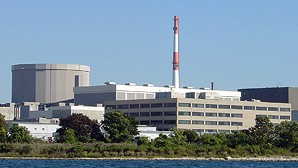In November 1977, workers at the Millstone nuclear plant in Connecticut attempted to unclog a pipe connected to a tank in the liquid radwaste system for the Unit 1 reactor. The liquid radwaste system features many large tanks to collect water that may be contaminated with radioactivity. The system has filters and demineralizers to treat the water for re-use in the plant or discharge to the ocean once its radiation levels have dropped sufficiently.
Several attempts to unclog the pipe failed. Workers then connected a hose to the pipe capable of delivering 100 pounds per square inch air pressure. They planned to pressurize the pipe to dislodge the clog.
Unfortunately, the tank was only designed for 15 pounds per square inch.
Fortunately, the tank had a relief vent that would automatically open to prevent overpressurization of the tank.
Unfortunately, previous tank overflows had filled the pipe leading to the relief valve with debris, which plugged the vent pathway.
Fortunately, no one was injured when the tank ruptured.
Our Takeway
One of my last jobs in the nuclear industry before coming to UCS in 1996 was working as a consultant to the company that owned and operated Millstone in those days. Haddam Neck, their other nuclear plant in Connecticut, was in the NRC’s regulatory doghouse and hundreds of consultants had been brought in to help make nice with the NRC.
John Hazeltine, a senior manager for the company, taught an orientation course for incoming consultants. Hazeltine spoke about the risks from not verifying assumptions, not confirming that references are still applicable, and similar shortcuts. He pointed out that such shortcuts place more and more reliance on luck. “Luck makes a lousy barrier,” Hazeltine concluded, imploring us to avoid taking shortcuts and the bad luck they can bring. It remains among the soundest counsel I’ve had during my professional career.
Assuming that the tank was designed for the same pressure as its piping and assuming that the installed relief valve would function properly if needed would have looked valid had good luck resulted in the air blowing out the clog before the tank ruptured. But bad luck stepped in and destroyed those assumptions along with the tank.
Dr. Pietro “Pete” Pasqua headed the nuclear engineering department at the University of Tennessee when I attended. He taught us that it was only sufficient to have all the right answers when one has asked all the right questions. A few more questions in this episode might have prevented bad luck.
“Fission Stories” is a weekly feature by Dave Lochbaum. For more information on nuclear power safety, see the nuclear safety section of UCS’s website and our interactive map, the Nuclear Power Information Tracker.

